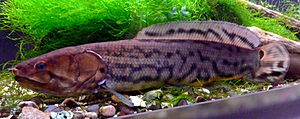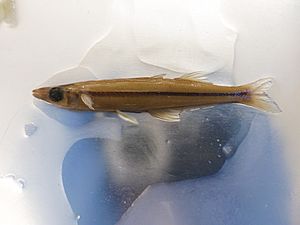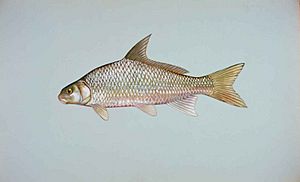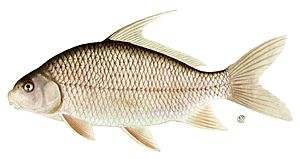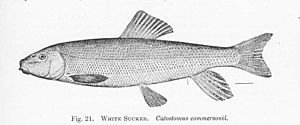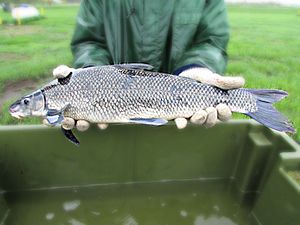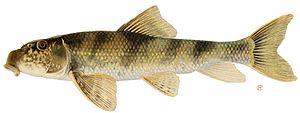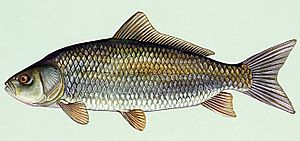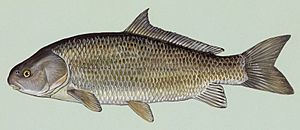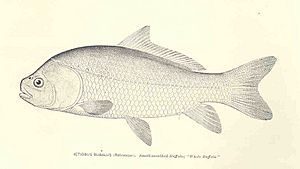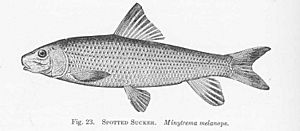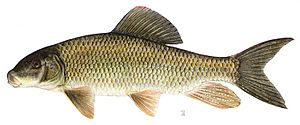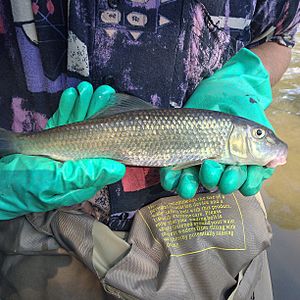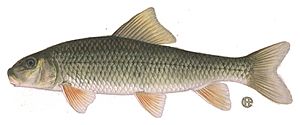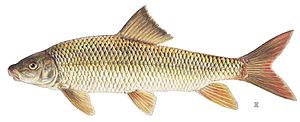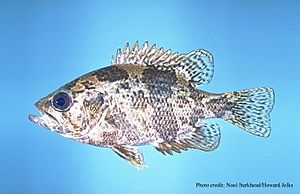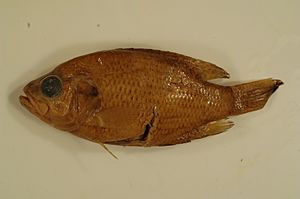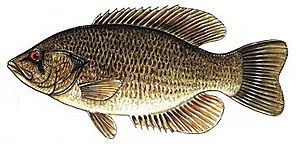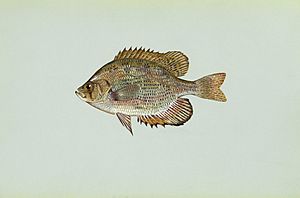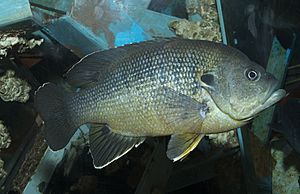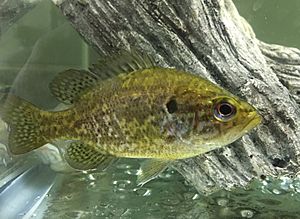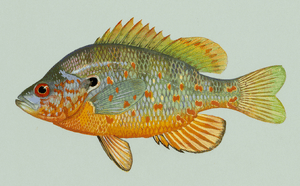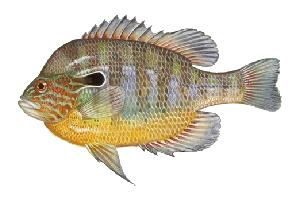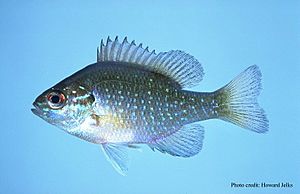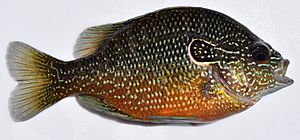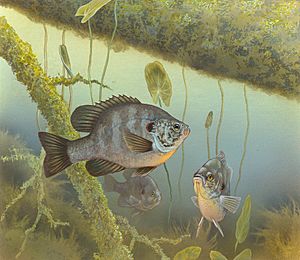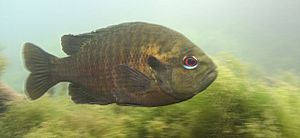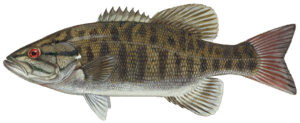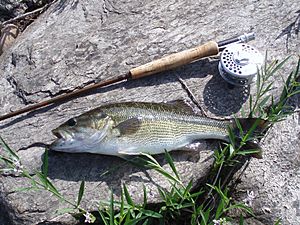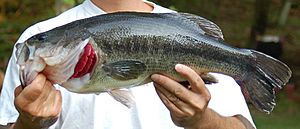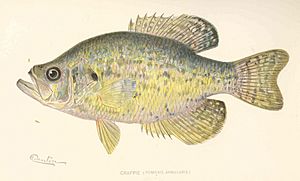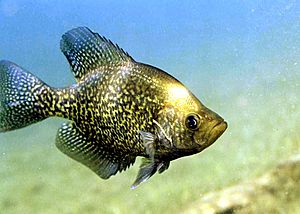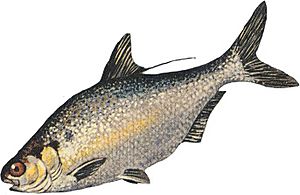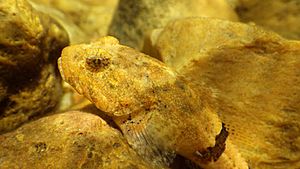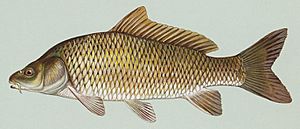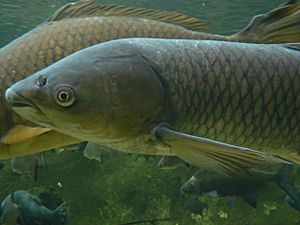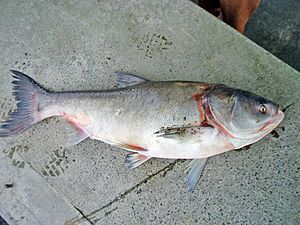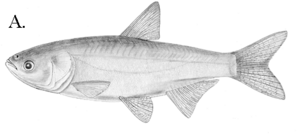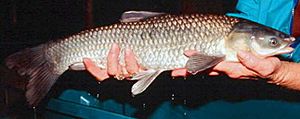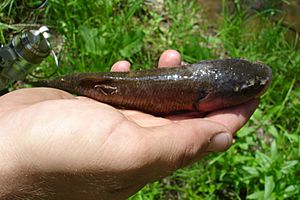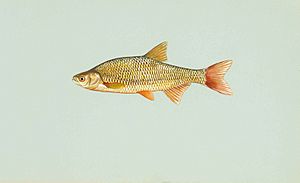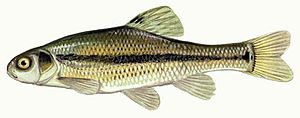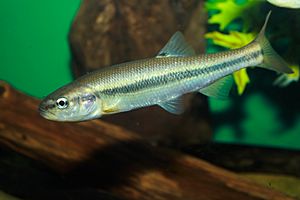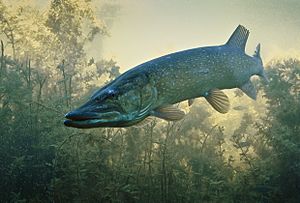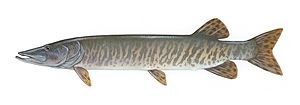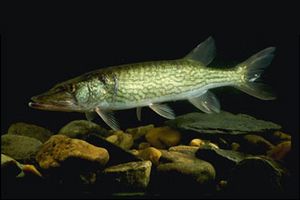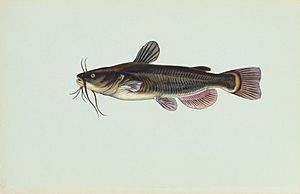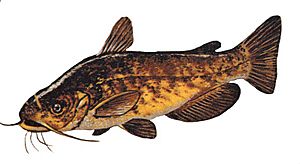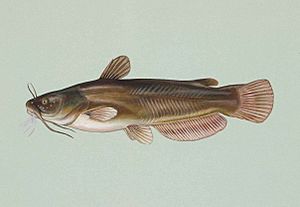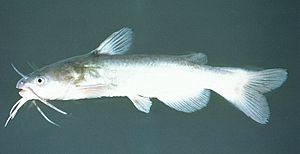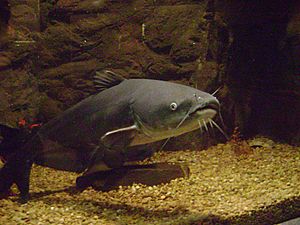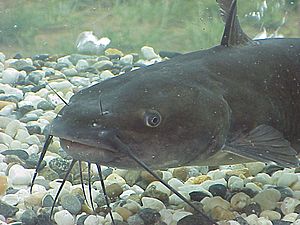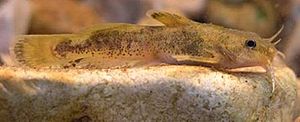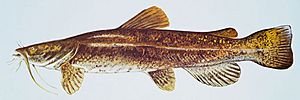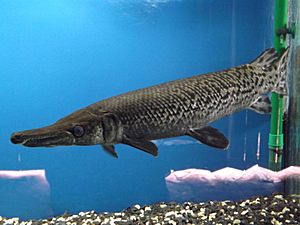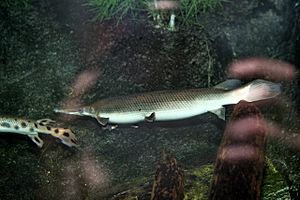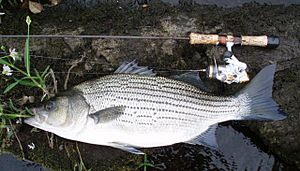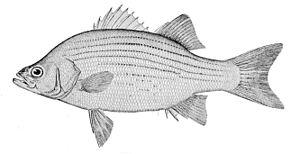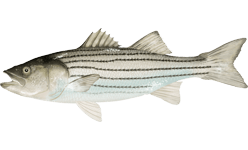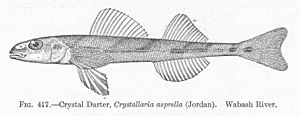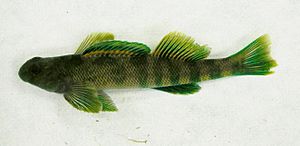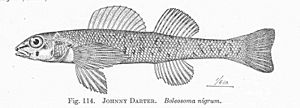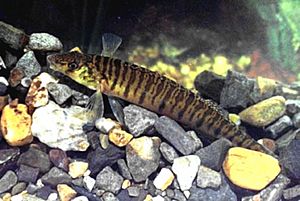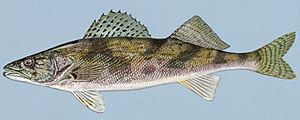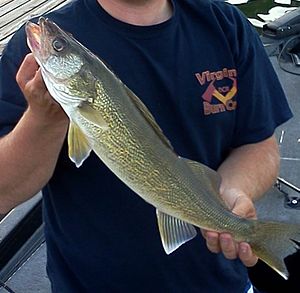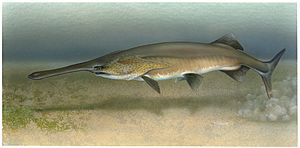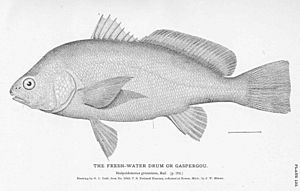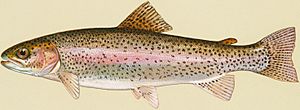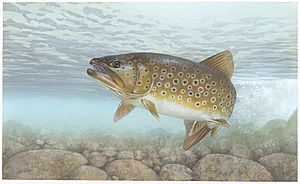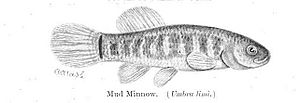List of fishes of Missouri facts for kids
Missouri is home to a huge variety of fish, with over 200 different kinds swimming in its waters! From tiny minnows to large sturgeon, these fish live in all sorts of places, like clear streams, big rivers, and calm lakes. Learning about them helps us understand the amazing natural world around us and how we can protect it.
Contents
- Fish Families of Missouri
- Acipenseridae (Sturgeon Family)
- Amiidae (Bowfin Family)
- Anguillidae (Eel Family)
- Atherinidae (Silverside Family)
- Catostomidae (Sucker Family)
- Centrarchidae (Sunfish and Bass Family)
- Clupeidae (Herring and Shad Family)
- Cottidae (Sculpin Family)
- Cyprinidae (Minnow and Carp Family)
- Esocidae (Pike Family)
- Fundulidae (Topminnow Family)
- Hiodontidae (Mooneye Family)
- Ictaluridae (Catfish Family)
- Lepisosteidae (Gar Family)
- Moronidae (Temperate Bass Family)
- Percidae (Perch and Darter Family)
- Petromyzontidae (Lamprey Family)
- Polyodontidae (Paddlefish Family)
- Sciaenidae (Drum Family)
- Salmonidae (Trout Family)
- Umbridae (Mudminnow Family)
Fish Families of Missouri
Many fish are grouped into "families" based on similar features. Think of it like your own family, where everyone shares some traits! Here are some of the interesting fish families you can find in Missouri.
Acipenseridae (Sturgeon Family)
This family includes some of the oldest and largest fish.
- Lake Sturgeon (Acipenser fulvescens)
These ancient fish live at the bottom of big lakes and rivers. They prefer areas with sand, gravel, or rocky bottoms. Sadly, the lake sturgeon is an endangered species, meaning there are very few left, and they need our help to survive.
Amiidae (Bowfin Family)
The Bowfin is the only living member of its family.
- Bowfin (Amia calva)
Bowfins like slow-moving waters such as sloughs (swampy areas) and calm rivers. They are tough fish that can breathe air, which helps them survive in waters with low oxygen.
Anguillidae (Eel Family)
This family is known for its snake-like fish.
- American Eel (Anguilla rostrate)
American eels are unique because they live in fresh water but travel all the way to the ocean to lay their eggs. They prefer large rivers with a steady flow.
Atherinidae (Silverside Family)
These fish are often small and have a silvery stripe along their sides.
- Brook Silverside (Labidesthes sicculus)
Brook silversides enjoy clear, warm waters that don't have much current. You can often find them in calm backwaters or overflow pools of larger streams.
Catostomidae (Sucker Family)
Suckers are known for their fleshy, downward-pointing mouths, which they use to feed on the bottom.
- River Carpsucker (Carpiodes carpio)
These fish are found in lakes, reservoirs, and large, slow-moving rivers.
- Quillback (Carpiodes cyprinus)
Quillbacks prefer large to medium rivers with fast currents, as well as lakes.
- Highfin Carpsucker (Carpiodes velifer)
These fish also live in lakes, reservoirs, and big, sluggish rivers.
- White Sucker (Catostomus commersonii)
White suckers can be found in rocky pools of small, cool streams or large rivers and lakes.
- Blue Sucker (Cycleptus elongates)
Blue suckers live in the deep channels of large rivers where the water flows quickly. They are an endangered species in Missouri.
- Northern Hogsucker (Hypentelium nigricans)
You can find northern hogsuckers in rocky areas and flowing pools of cool, small to medium streams.
- Bigmouth Buffalo (Ictiobus cyprinellus)
These large fish live in streams, rivers, bayous (slow-moving channels), backwaters, and lakes.
- Black Buffalo (Ictiobus niger)
Black buffalo prefer the deep waters of medium to large rivers and lakes.
- Smallmouth Buffalo (Ictiobus bubalus)
Similar to their relatives, smallmouth buffalo are found in medium to large rivers and lakes.
- Spotted Sucker (Minytrema melanops)
Spotted suckers live in large rivers, streams with deep pools, sloughs, and backwaters.
- Silver Redhorse (Moxostoma anisurum)
These fish prefer muddy to rocky bottom pools in streams and large rivers.
- River Redhorse (Moxostoma carinatum)
River redhorse live in small streams and rivers with a moderate current over gravel bottoms.
- Black Redhorse (Moxostoma duquesnei)
Black redhorse are found in lakes and river pools with sandy or rocky bottoms.
- Golden Redhorse (Moxostoma erythrurum)
These fish like clear pools of large rivers and moderately flowing small streams with sandy or gravel bottoms.
- Shorthead Redhorse (Moxostoma macrolepidotum)
Shorthead redhorse live in rocky pools and riffles (shallow, fast-moving water) of small streams and large rivers.
Centrarchidae (Sunfish and Bass Family)
This popular family includes many well-known sport fish.
- Shadow Bass (Ambloplites ariommus)
Shadow bass prefer cool, clear streams with moderate flow, often hiding among logs and tree roots.
- Ozark Bass (Ambloplites constellatus)
Like shadow bass, Ozark bass live in cool, clear streams with moderate flow, near logs and tree roots.
- Rock Bass (Ambloplites rupestris)
Rock bass also enjoy cool, clear streams with moderate flow, using logs and tree roots for cover.
- Flier (Centrarchus macropterus)
Fliers are found in sluggish streams, ditches, and wetlands that have lots of plants.
- Green Sunfish (Lepomis cyanellus)
These adaptable fish can live in clear or muddy water, from small streams to big rivers, lakes, and reservoirs.
- Warmouth (Lepomis gulosus)
Warmouths prefer sluggish streams, ponds, lakes, and wetlands with lots of plants and flooded trees.
- Orangespotted Sunfish (Lepomis humilis)
These sunfish live in slow-moving rivers and streams with muddy bottoms.
- Bluegill (Lepomis macrochirus)
Bluegill are common in warm, clear streams with moderate flow, ditches, ponds, and lakes.
- Dollar Sunfish (Lepomis marginatus)
Dollar sunfish are found in sluggish streams, backwaters, and bayous.
- Longear Sunfish (Lepomis megalotis)
These colorful fish prefer slow pools in moderately flowing small to large streams with rocky bottoms, and also lakes.
- Redear Sunfish (Lepomis microlophus)
Redear sunfish live in pools of slow-moving warm streams, ponds, and lakes with lots of plants.
- Redspotted Sunfish (Lepomis miniatus)
These fish are found in small to moderate flowing streams with slow currents, oxbows (U-shaped bends in rivers), and swamps.
- Smallmouth Bass (Micropterus dolomieu)
Smallmouth bass prefer cool, clear, rocky streams with moderate flow and deep reservoirs.
- Spotted Bass (Micropterus punctulatus)
Spotted bass live in warm creeks and rivers with pools, and deep reservoirs.
- Largemouth Bass (Micropterus salmoides)
Largemouth bass are very common and live in slow-moving streams, farm ponds, lakes, and reservoirs.
- White Crappie (Pomoxis annularis)
White crappie are found in lakes, reservoirs, large ponds, and moderate streams.
- Black Crappie (Pomoxis nigromaculatus)
Black crappie also live in lakes, reservoirs, large ponds, but prefer clearer streams.
Clupeidae (Herring and Shad Family)
This family includes fish that often travel in large groups.
- Gizzard Shad (Dorosoma cepedianum)
Gizzard shad prefer quiet waters like lowland lakes, ponds, pools, and backwaters of streams and rivers.
Cottidae (Sculpin Family)
Sculpins are small, bottom-dwelling fish with large heads.
- Banded Sculpin (Cottus carolinae)
Banded sculpins live in quiet water habitats, lowland lakes, ponds, pools, and backwaters of streams and rivers.
- Grotto Sculpin (Cottus specus)
This unique fish is found in only a few caves and one stream in Perry County, Missouri. It is an endangered species.
Cyprinidae (Minnow and Carp Family)
This is the largest family of fish in North America, including many small species.
- Central Stoneroller (Campostoma pullum)
Central stonerollers live in small to medium streams with moderate to high slopes and rocky bottoms, often near fast-moving water.
- Common Carp (Cyprinus carpio)
Common carp are found in lakes, reservoirs, ponds, ditches, rivers, and creeks. They are an invasive species, meaning they are not native to Missouri and can harm local ecosystems.
- Grass Carp (Clenopharyngodon idella)
Grass carp live in large rivers, streams, ponds, and lakes. They are also an invasive species.
- Cypress Minnow (Hybognathus hayi)
Cypress minnows prefer backwaters of large, sluggish rivers and oxbows. They are an endangered species.
- Silver Carp (Hypophthalmichthys molitrix)
Silver carp are found in large rivers and lakes. They are an invasive species known for jumping out of the water when startled.
- Bighead Carp (Hypophthalmichthys nobilis)
Bighead carp also live in large rivers and lakes and are another invasive species.
- Common Shiner (Luxilus cornutus)
Common shiners prefer small, moderately clear streams with gravel and rubble bottoms, and rocky pools.
- Duskystripe Shiner (Luxilus pilsbryi)
Duskystripe shiners live in stream pools with clean gravel bottoms.
- Bleeding Shiner (Luxilus zonatus)
Bleeding shiners are found in the middle of the water in small creeks and large rivers, preferring clean, gravelly or rocky bottoms, near fast-moving water or in pools.
- Black Carp (Mylopharyngodon piceus)
Black carp are found in lakes, rivers, and streams. They are an invasive species that escaped from fish farms during floods.
- Hornyhead Chub (Nocomis biguttatus)
Hornyhead chubs live in clear streams with constant flow and clean gravel.
- Golden Shiner (Notemigonus crysoleucas)
Golden shiners prefer sloughs, ponds, lakes, and quiet pools of streams.
- Fathead Minnow (Pimephales promelas)
Fathead minnows are found in the middle of the water or near the bottom in streams and pools.
- Flathead Chub (Platygobio gracilis)
Flathead chubs live in big rivers, preferring bottoms made of sand and fine gravel. They are an endangered species.
- Creek Chub (Semotilus atromaculatus)
Creek chubs are found in pools of headwater streams and large rivers with rocky bottoms.
Esocidae (Pike Family)
This family includes long, slender fish with sharp teeth, known as predators.
- Grass Pickerel (Esox americanus vermiculatus)
Grass pickerel are found in small headwater streams.
- Northern Pike (Esox lucius)
Northern pike live in lakes, reservoirs, rivers, and streams that have lots of plants.
- Muskellunge (Esox masquinongy)
Muskellunge prefer clear waters of weedy lakes and medium rivers.
- Chain Pickerel (Esox niger)
Chain pickerel are found in lakes, reservoirs, rivers, and streams with lots of plants.
Fundulidae (Topminnow Family)
Topminnows are small fish that often swim near the surface.
- Blackspotted Topminnow (Fundulus olivaceus)
Blackspotted topminnows live in large lowland rivers and pools of streams.
- Blackstripe Topminnow (Fundulus notatus)
Blackstripe topminnows are also found in large lowland rivers and pools of streams.
Hiodontidae (Mooneye Family)
This family includes fish with large eyes.
- Goldeye (Hiodon alosoides)
Goldeyes live in large rivers, backwaters, and lakes.
Ictaluridae (Catfish Family)
Catfish are known for their "whiskers" called barbels, which help them find food.
- Black Bullhead (Ameiurus melas)
Black bullheads prefer slow-flowing streams, oxbows, and backwaters with muddy bottoms.
- Brown Bullhead (Ameiurus nebulosus)
Brown bullheads are found in oxbows, backwaters with muddy bottoms, and slow-flowing streams.
- Yellow Bullhead (Ameiurus natalis)
Yellow bullheads live in slow-flowing streams, backwaters, and ponds and lakes with plants.
- White Bullhead (Ameiurus catus)
White bullheads prefer clear streams and the waters below dams.
- Blue Catfish (Ictalurus furcatus)
Blue catfish live in rivers and large creeks with fast water over sandy or rocky bottoms.
- Channel Catfish (Ictalurus punctatus)
Channel catfish are very common and found in ponds, lakes, and moderately flowing rivers and creeks with sandy or gravel bottoms.
- Mountain Madtom (Noturus eleutherus)
Mountain madtoms live in large, moderately clear rivers. They are an endangered species.
- Stonecat (Noturus flavus)
Stonecats prefer clear, gravel-bottom streams.
- Neosho Madtom (Noturus placidus)
Neosho madtoms live in medium to large streams with clear waters. They are an endangered species.
- Flathead Catfish (Pylodictis olivaris)
Flathead catfish are found in large rivers and creeks with currents, often near logs, roots, rocks, and other debris.
Lepisosteidae (Gar Family)
Gars are ancient fish with long, slender bodies and sharp teeth.
- Alligator Gar (Atractosteus spatula)
Alligator gars live in large, slow-flowing rivers, lakes, bayous, and reservoirs. They are one of the largest freshwater fish in North America.
- Shortnose Gar (Lepisosteus platostomus)
Shortnose gars prefer muddy rivers, oxbows, backwaters, and lakes.
- Longnose Gar (Lepisosteus osseus)
Longnose gars are found in bayous, backwaters, oxbows, large creeks, rivers, and lakes.
Moronidae (Temperate Bass Family)
This family includes popular sport fish like white bass and striped bass.
- Hybrid Striped Bass (Morone chrysops x Morone saxatilis)
These fish are a mix of white bass and striped bass. They live in large streams with moderate flow, sandy or rocky bottoms, and reservoirs.
- White Bass (Morone chrysops)
White bass prefer large streams with moderate flow, sandy or rocky bottoms, and reservoirs.
- Striped Bass (Morone saxatilis)
Striped bass are found in large, deep reservoirs.
Percidae (Perch and Darter Family)
This family includes many colorful and active fish.
- Crystal Darter (Crystallaria asprella)
Crystal darters live in open channels of large, clear streams. They are an endangered species.
- Greenside Darter (Etheostoma blennioides)
Greenside darters prefer streams and rivers with swift to moderate currents.
- Arkansas Darter (Etheostoma cragini)
Arkansas darters live in shallow, spring-fed streams with sandy bottoms, mainly in the Spring River system of the southwestern Ozarks.
- Harlequin Darter (Etheostoma histrio)
Harlequin darters are found in streams and ditches, preferring sandy bottoms with logs, sticks, and other natural debris. They are an endangered species.
- Johnny Darter (Etheostoma nigrum)
Johnny darters live in pools and slow-moving riffles in sandy streams.
- Goldstripe Darter (Etheostoma parvipinne)
Goldstripe darters prefer small, shallow, spring-fed streams with low to moderate slopes. They are an endangered species.
- Logperch (Percina caprodes)
Logperch are found in deep riffles and clear pools of small to medium-sized rivers.
- Sauger (Sander canadensis)
Sauger prefer cloudy water in streams and rivers with moderate or fast flow, and large lakes and reservoirs.
- Walleye (Sander vitreus)
Walleye live in deep water of large streams, lakes, and reservoirs with sandy or rocky bottoms.
Petromyzontidae (Lamprey Family)
Lampreys are ancient, jawless fish.
- Chestnut Lamprey (Ichthyomyzon castaneus)
Chestnut lampreys are found in large streams and small rivers, as well as large reservoirs.
Polyodontidae (Paddlefish Family)
This family has only two living species, one of which is found in Missouri.
- Paddlefish (Polyodon spathula)
Paddlefish are unique for their long, paddle-shaped snouts. They live in the channels of large to medium rivers with moderate flow.
Sciaenidae (Drum Family)
This family includes fish that can make drumming sounds.
- Freshwater Drum (Aplodinotus grunniens)
Freshwater drums live in medium to large rivers, lakes, and reservoirs with deep water.
Salmonidae (Trout Family)
This family includes popular cold-water fish.
- Rainbow Trout (Oncorhynchus mykiss)
Rainbow trout are found in large rivers to small streams, lakes, and below dams. They are often stocked in Missouri's cold-water streams.
- Brown Trout (Salmo trutta)
Brown trout live in lakes, small streams, and large rivers, also preferring cooler waters.
Umbridae (Mudminnow Family)
Mudminnows are small, hardy fish.
- Central Mudminnow (Umbra limi)
Central mudminnows live in bogs, sloughs, swamps, and sluggish streams. They are an endangered species in Missouri.



